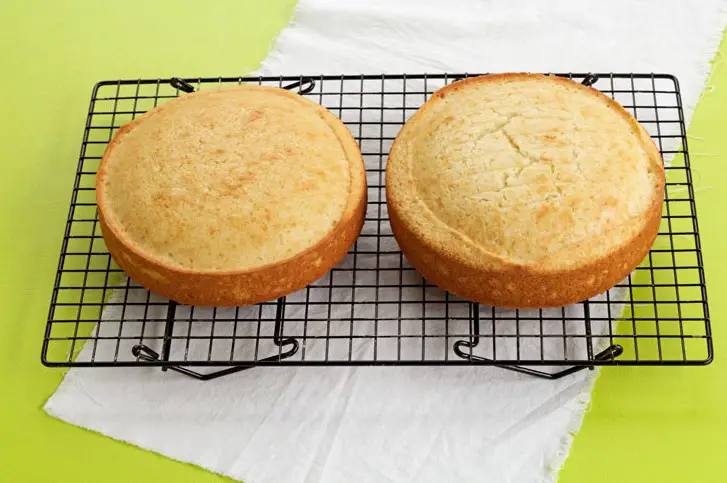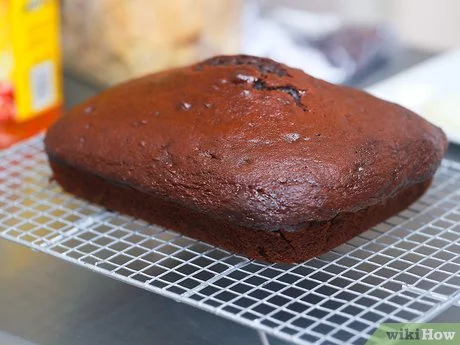The fridge can be a strange place. It is full of food, and some people use it to keep their food fresh. However, many other uses for the fridge are less than obvious.
For example, you can freeze the cake and then store it in the refrigerator, so it stays cool longer than when you first bought it from the bakery.
This trick will work with most cakes and treats but might not work with moist ones like brownies or cookies.
Can You Cool A Cake In The Fridge?
Yes! You can cool a cake in the fridge to make it last longer. Put your cake in a plastic container, wrap it tightly, and then put the container inside your refrigerator. It will stay cool for quite a while.
This method is excellent for storing your cake for an upcoming occasion. When your guests arrive, you can pull the cake from the fridge and serve it up.

How Do You Cool Down A Cake Quickly?
You can use any plastic container, but you may want to use an airtight container, so it does not dry out. You can also use an ice cube tray or a plastic bag filled with ice.
Put your cake in the container and cover it with a layer of iced cubes. The cake will then have frozen slushy cubes that absorb any moisture and leave your cake very cold.

Can You Put Hot Cake In The Fridge?
No, you cannot put the hot cake in the fridge. Hot food will spoil any other food, so you want to wait until your cake has cooled before you put it in the refrigerator. This is especially true if there are other foods around to spoil.
It may be best to stick with cake pops or cupcakes, as these treats can cool down quickly and not need to be put in the refrigerator immediately.
Should I Put Cake In Fridge After Icing?
Sometimes you may want to put your cake in the fridge for a few hours or a day before serving. This will keep it from getting soggy and fresh so that it tastes good.
Do You Need To Remove The Cake From Freezer And Fridge Before Serving?
Yes, you need to remove the cake from the freezer and fridge before serving. This will allow the cake to come to room temperature and soften, so that it is easier to cut and enjoy.
The amount of time you need to thaw the cake will depend on the size of the cake and whether it is frozen or refrigerated.
How Long Will Cake Last In The Fridge?
You can completely cool a cake in your refrigerator and then store it there for up to a week or two.
You can also put your frosting on the cake and put it back into the fridge to cool for several more days.
Why Do Cakes Get Hard After Cooling?
Cakes can harden after cooling due to a combination of factors, including:
1. Evaporation of moisture: As cakes cool, the moisture they contain starts to evaporate, leading to a drier and harder texture.
2. Starch gelatinization: Starch, a key ingredient in flour, undergoes a process called gelatinization when heated. As the cake cools, this gelatinized starch sets, contributing to the hardening process.
3. Crystallization of sugar: Sugar also plays a role in cake hardening. When the cake cools, the dissolved sugar molecules tend to rearrange and form crystals, which can make the cake feel firmer.
4. Gluten development: Overmixing the cake batter can lead to the development of gluten, a protein found in wheat flour.
Excessive gluten can make the cake tough and dry, contributing to its hardness after cooling.
5. Refrigeration: Storing a cake in the refrigerator can further accelerate the drying process, making it even harder.
How Do You Make Cake Soft After Being In The Fridge?
Cake can get too hard if you do not take it out of the refrigerator long enough. You may also notice that the frosting on your cake may have also hardened.
The first thing to do is make sure that you remove it from the refrigerator before eating.
If you use a cold frosting and place it back in your fridge, strain any excess moisture from it and put it on the cake again.
How Do You Get The Smoothest Cake?
Achieving a smooth cake finish requires a combination of proper baking techniques, appropriate tools, and careful frosting methods. Here’s a step-by-step guide to achieving a smooth cake finish:
Step 1: Start with Evenly Baked Cake Layers
Level the Cake Layers: Once the cakes have cooled completely, use a serrated knife or cake leveler to trim off any domed tops or uneven edges. This will ensure that the cake layers stack evenly.
Chill the Cake Layers: Wrap the leveled cake layers tightly in plastic wrap or aluminum foil and refrigerate them for at least 30 minutes, or up to 24 hours. Chilling the cakes will make them firmer and easier to handle, reducing the risk of crumbs when frosting.
Step 2: Apply a Crumb Coat
Prepare the Frosting: Bring the frosting to room temperature so it is soft and spreadable.
Position the Cake: Place the chilled cake layer on a cake turntable or a flat surface.
Apply a Thin Layer of Frosting: Using an offset spatula, spread a thin layer of frosting evenly over the top of the cake layer. This crumb coat will seal in any crumbs and provide a smooth base for the final frosting layer.
Refrigerate the Crumb Coat: Refrigerate the frosted cake layer for at least 30 minutes, or up to 24 hours. This will allow the crumb coat to firm up and create a stable foundation for the final frosting layer.
Step 3: Apply the Final Frosting Layer
Prepare the Final Frosting: Bring the frosting to room temperature again for easy spreading.
Pipe a Border of Frosting: Use a piping bag fitted with a large round tip to pipe a border of frosting around the top edge of the cake layer. This border will help to prevent the frosting from sliding off the sides of the cake.
Fill the Center with Frosting: Apply a generous amount of frosting to the center of the cake layer, using an offset spatula to spread it evenly.
Smooth the Frosting: Using an angled cake smoother or a large offset spatula, gently smooth the frosting over the top of the cake layer, working from the center outwards.
Rotate the Cake: If using a cake turntable, rotate the cake as you smooth the frosting to ensure even coverage.
Smooth the Sides: Tilt the cake smoother or spatula slightly and run it along the sides of the cake, applying gentle pressure to smooth out any bumps or unevenness.
Repeat for Additional Layers: Stack the remaining cake layers, applying a crumb coat, refrigerating, and applying the final frosting layer for each layer.
Step 4: Final Touches
Check for Gaps: Once the final frosting layer is applied, check for any gaps or imperfections. Use a small offset spatula or a pastry brush to fill in any gaps and smooth out any irregularities.
Refrigerate or Serve: If desired, refrigerate the frosted cake for at least 30 minutes to allow the frosting to firm up before serving
Conclusion
You can store your cake in the fridge to keep it fresh and tasty. The temperature in your refrigerator keeps the cake from getting too moist so that it will last for quite some time.
If you wrap the cake tightly or put it into a sealed container, you can enjoy your delicious treat for several days after baking it or ordering it from a store.